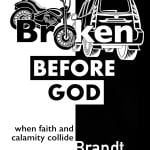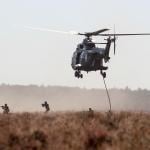 Chapter 6 of J. Richard Middleton’s book The Liberating Image: The Imago Dei in Genesis 1 addresses the question of the nature of God revealed in creation. Most of the Mesopotamian creation myths involve creation as part of some great cosmic battle. This combat motif is also present in Canaanite myths. Scholars have found traces of the combat creation myths common in the ancient Near East in the Old Testament. Some believe that this cosmic battle motif is so deep in the psyche of the time and place that it defines all of the creation texts, including Genesis 1.
Chapter 6 of J. Richard Middleton’s book The Liberating Image: The Imago Dei in Genesis 1 addresses the question of the nature of God revealed in creation. Most of the Mesopotamian creation myths involve creation as part of some great cosmic battle. This combat motif is also present in Canaanite myths. Scholars have found traces of the combat creation myths common in the ancient Near East in the Old Testament. Some believe that this cosmic battle motif is so deep in the psyche of the time and place that it defines all of the creation texts, including Genesis 1.
But is this true? Is creation in the Old Testament depicted as the result of a cosmic battle?
This is an important question. A portrait of God as cosmic warrior will have significant implications for our understanding of the role of humans as the image of God. As Middleton poses the question:”If the imago Dei refers to human rule of the earth, what sort of rule is envisioned?” If creation is depicted as a combat between good (God) and chaos or evil, this will set the tone for the human exercise of power as well. Humans, as the image of God, are charged with holding back the forces of chaos and evil … in combat from Genesis 1 onward.
More than this … Middleton argues that creation-by-combat leads to an ethic that is centered on the benefit of a particular society – Babylon, Israel, Christendom, America. “The world that is founded by primordial combat is thus the world of some particular group with their own limited interests.” (p. 251)
This can be a real issue. According to Middleton:
The consequence of defining one’s own people or nation as the normative and true humanity, whose origin is traced back to and grounded in creation itself, is that everyone else is relegated to the status of other – other than truly human, other than legitimate, other than normative – and thus regarded as inferior in status if not downright evil. Particularly when a people’s national/ethnic identity is both grounded in creation and understood to be established by the conquest of chaos, then threats to this identity must be vanquished by enacting the chaos battle against one’s historical competitors, who are understood as enemies of righteousness. (p. 252)
This battle against the forces of chaos grounded in the rightness of being the people of God can be seen in ideological polarizations in the world today. It penetrates into the ethos of a people. When creation-by-combat is portrayed the nature of reality is not fundamentally good, designed for human flourishing. Violence is original and at the core of the way the world is, always to be held at bay by the divine and by the divine image. This ethos can lead to a validation of oppression, or a justification for the violent overthrow of powers other than “us.” The false universalism in creation leads to an inherent us-versus-them mentality seen throughout history and in our world today.
Creation-by Combat in the Old Testament. The creation-by-combat theme is present in the Old testament. Middleton finds three clear creation-by-combat texts: Job 26:7-14, Psalm 74:12-17; Psalm 89:5-14. There are other combat texts that appear to draw on ancient Near Eastern combat myths, but these do not involve creation. According to Middleton they describe “God’s struggle with and judgment on various political empires, either in the historical past or in the eschatological future.” (p. 244)
In Job 26 creation-by-combat evokes awe concerning the mystery of God.
The pillars of heaven tremble,
and are astounded at his rebuke.
By his power he stilled the Sea;
by his understanding he struck down Rahab.
By his wind the heavens were made fair;
his hand pierced the fleeing serpent.
These are indeed but the outskirts of his ways;
and how small a whisper do we hear of him!
But the thunder of his power who can understand? (Job 26:11-14)
This passage does not really have much impact on the interpretation of the imago Dei and the rule of humans on earth.
The passages from the Psalms on the other hand “link creation-by-combat in the divine realm with human institutions (and human power) on earth” (p. 246) with potential implications for the nature of human rule as the imago Dei. First Psalm 74:12-17.
Yet God my King is from of old,
working salvation in the earth.
You divided the sea by your might;
you broke the heads of the dragons in the waters.
You crushed the heads of Leviathan;
you gave him as food for the creatures of the wilderness.
You cut openings for springs and torrents;
you dried up ever-flowing streams.
Yours is the day, yours also the night;
you established the luminaries and the sun.
You have fixed all the bounds of the earth;
you made summer and winter.
Here God is depicted as working salvation in creation. In the Psalm this sets up the expectation and call for God to work salvation once again in defeating the enemies of Israel who have destroyed the holy temple as described in the 74:2-8.
Psalm 89 is even more interesting. The creation-by-combat motif in 89:10-15 is linked to God’s anointing of David and his promise to preserve the Davidic line. God founded the world, rules the raging seas, and crushed Rahab and God gives David power over the sea and the rivers. The Davidic king is given the task as God’s representative of maintaining order. Middleton concludes:
Psalm 89 thus illustrates very well the function of the creation-by-combat theme to legitimate the monarchy, via a motif remarkably like the imago Dei. Indeed, the term highest (‘elyôn), used of the Davidic king in 89:27 (MT 89:28), may also indicate the ancient Near Eastern notion of the kings affinity/likeness to the divine[.] (p. 249)
The psalm is a lament asking when God will remember his promise and restore the Davidic line – but the role of the king is that of a combatant holding back the forces of chaos and subduing Israel’s enemies.
Back to Genesis. In Middleton’s view the big question, however, is not the presence of creation-by-combat in psalms of lament or the dialog of Job. These may reflect the surrounding culture without affirming the nature of God’s creation or the role of humankind as the image of God. The big question is the presence or absence of creation-by-combat in Genesis 1-2. This is the passage that begins and shapes the narrative of scripture – God’s creation. It is the overture to the entire Bible. Middleton sees three aspects of Genesis 1 that contradict the creation-by-combat theme.
1. The traditional chaotic elements, water, seas, the deep, are not portrayed as God’s enemies. “In Genesis 1, the deep is no threat, and so God does not need to fight it.” The deep is demythologized along with the sea monsters or dragons in 1:21. The mythological adversaries are nothing more than created parts of God’s world. This has connection with Psalm 104:26 where Leviathan was formed to sport in the sea.
2. God creates with decided ease, there is no resistance.
God commands, and the creation obeys God’s every word. To put it differently, God rules willing subjects, who do not have to be coerced or subdued to his will.
Indeed, this is a ruler who does not command so much as invite creation to respond to his will. This invitational character of God’s creative fiats is indicated by their not being imperatives at all, but Hebrew jussives (which have no exact counterpart in English). … The ease of creation – indicated both by the jussives and by the immediate compliance of creatures – is a prominent rhetorical feature of Genesis 1, reflected even in the gentle, repetitive cadences of the text, which progressively builds to a climax, but unlike a genuine narrative contains not a trace of plot tension or resolution (that is, there is no evil to be resisted or overcome). (p. 265)
3. God’s evaluation of each stage of creation as “good” and the finished product as “very good”. The Hebrew word used for good has both ethical and esthetic connotation.
The cosmos is good in two senses: it is both pleasing to God, as a beautiful, well-constructed world, and it is evaluated positively since it enacts God’s will (and is not recalcitrant or rebellious). (p. 266)
This is not a fragile cosmic order imposed by God, but a good creation.
As the overture to the story of God’s mission in the world, Genesis 1 “signals the creator’s original intent for shalom and blessing at the outset of human history, prior to the rise of human (or divine) violence.” (p. 269) This is the normative framework through which we should view the rest of the story … including violence in the text of scripture and violence perpetuated in the name of religion today.
A comment. This was a quick summary of the thrust of Middleton’s discussion, hitting only the high points (or what I took as the high points). There is much food for thought in this chapter – from the way chaos and the ideal of a battle of good versus evil permeates our understanding of the world to the damaging effect of a false universalism that sets up “us” as right and “them” as wrong, even evil. Moving in a slightly different direction, this also has impact on the way we view Genesis 2 and 3 and connects with the understanding of Adam. I think many of the points raised by Middleton in his discussion pinpoint the discomfort I have with the idea of “Adam as Israel” in the interpretation of Genesis 2-3. The shape of “Adam as Israel” brings a false universalism to the narrative that can allow the people of God to view others as outside the blessing of God. Genesis founds the story of creation in God’s shalom and blessing for all people everywhere, not for a particular elect people.
What do you think?
Is the creation-by-combat theme an important one in scripture?
What impact does this have on your understanding of the world?
If you wish to contact me directly you may do so at rjs4mail [at] att.net.
If interested you can subscribe to a full text feed of my posts at Musings on Science and Theology.















